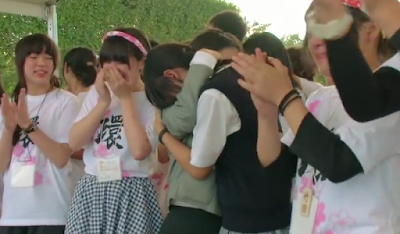Ce 11 mars 2016, le Japon commémorait les 5 ans du grand tsunami du Tôhoku, la région au nord-est de l'île principale. A peine 1h après un fort séisme au large, une vague de plusieurs mètres déferlait sur les côtes et rasait des quartiers entiers sur une large bande, tuant plus de 18 000 personnes sur le moment et 3000 disparus. Le bilan aurait pu être encore plus lourd sans l'excellent système d'alerte du Japon, qui avait tant fait défaut en 2004 dans l'Océan indien.
Et bien sûr cela provoqua la panne des circuits de refroidissement de la centrale nucléaire de Fukushima, dont les fuites ont contaminé une large zone encore aujourd'hui.
And of course, it broke the cooling circuits of the Fukushima nuclear plant, the leaks of which contaminated a large area still today.
En août 2014, j'ai eu la chance d'assister à la manifestation caritative organisée par l'école de l'OCDE du Tôhoku sur le Champ de Mars à Paris, qui a permis à ces élèves de se reconstruire un avenir. Pour l'occasion, la chanteuse et guitariste miwa avait répondu à leur invitation à créer une chanson, Kibô no Wa, "le Cercle de l'espoir", qu'elle était venue interpréter ! Une journée émouvante...
Vous pouvez en écouter un extrait en suivant les liens (vers son album de 2015, Oneness) ci-dessous si la vidéo suivante ne se lance pas.
Vous pouvez en écouter un extrait en suivant les liens (vers son album de 2015, Oneness) ci-dessous si la vidéo suivante ne se lance pas.
Dans le single correspondant, on peut voir un reportage sur cet événement :
In the corresponding single, a report on this event is available (DVD zone 2):
La hauteur des ballons bleus et rouges indiquait celle de la vague, pour donner une idée (accessoirement, on me voit sur la photo). Vous pouvez aussi voir le reportage et l'interview de miwa par Nolife ici.
In August 2014, I had the chance to assist the caritative manifestation organised by the OCDE school of Touhoku on the Champ de Mars in Paris, which allowed these students to rebuild temselves a future. For the occasion, the singer and guitar player miwa accepted their request to make a song, Kibou no Wa, "the Ring of Hope", which she interpreted there ! A moving day...
If the following video can't be played, you can listen to samples with the links above (from her 2015 album, Oneness).
If the following video can't be played, you can listen to samples with the links above (from her 2015 album, Oneness).
The height of the red and blue balloons indicated the one of the wave, to give an idea (by the way, I'm on that picture). You may also see the report and the interview of miwa by Nolife (French TV) here.
miwa - Kibô no wa (WA) 『希望の環(WA)』 à Paris, 2014.
5 ans après la catastrophe, le couple impérial et le 1er ministre participaient à une cérémonie. La reconstruction n'est pas encore partout en cours ; certaines grosses villes venant tout juste d'être simplement nettoyées des débris. Plus de 150 000 réfugiés vivent encore dans des lotissements de préfabriqués, dont ceux qui viennent de la zone contaminée par la centrale. Si les réacteurs de celle-ci sont stabilisés, au moins 2 ne sont toujours pas accessibles pour l'homme, et la quantité de déchets et d'eau de refroidissement à traiter est énorme. La centrale était bien protégée par des digues, mais leur hauteur n'était pas prévue pour un tel événement jugé "rare"...
Le Japon avait alors arrêté tous ses réacteurs, même ceux en pleine terre, pour un audit général. Il en a redémarré 2 il y a peu de temps malgré l'hostilité de la population. Il faut dire que le pays ne possède aucun gisement de matières fossiles, dont les importations semblent peser plus lourd. En parallèle, on voit pas mal de pubs d'entreprises de pause de panneaux photovoltaïques, et des installations d'éoliennes bien que le terrain escarpé s'y prête peu.
5 years after the catastroph, the imperial couple and the prime minister participated to a ceremony. Reconstruction has not yet begun everywhere, some cities being just cleared from all the thrash. More than 150,000 refugees still live in prefab suburbs, including of the ones coming from the contaminated area. Although the reactors are stabilized, at least 2 of them are still out of reach for humans, and the quantity of contaminated thrash and water is huge. The plant was of course protected by a wall but its height was not enough for such an event, considered "rare".
Japan had stopped all its reactors at that time, even in middle of lands, for an audit. It restarted 2 of them in spite of the people hostility. It's true that the country has no fossil energy reserve and their importation seems to cost more. In parallel, we can see several ads for photovoltaic panels installations, and more wind plants, though their implantation is complicated on this sharp territory.




Aucun commentaire:
Enregistrer un commentaire